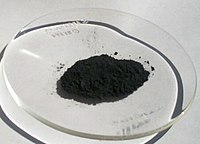
Photo from wikipedia
Abstract Temperature- and carbon dioxide (CO2)-responsive block copolymers of dimethylaminoethyl methacrylate (DMAEMA) and N-isopropylacrylamide (NIPAAm) (PDMAEMA-b-PNIPAAm) with different block lengths were synthesized by atom transfer radical polymerization (ATRP). In addition,… Click to show full abstract
Abstract Temperature- and carbon dioxide (CO2)-responsive block copolymers of dimethylaminoethyl methacrylate (DMAEMA) and N-isopropylacrylamide (NIPAAm) (PDMAEMA-b-PNIPAAm) with different block lengths were synthesized by atom transfer radical polymerization (ATRP). In addition, cellulose nanocrystals (CNCs) were grafted with PDMAEMA-b-PNIPAAm chains through surface initiated-ATRP. After studying self-assembly and responsivity of the free PDMAEMA-b-PNIPAAm to different stimuli, the free and CNC-grafted PDMAEMA-b-PNIPAAm chains were finally used as CO2-switched absorbents of nitrate ions from aqueous solutions. Temperature responsivity investigations showed different critical solution temperatures (CST) for the copolymers depending on the length of blocks. CO2-responsivity of the copolymers is accompanied by reduction of pH upon the purging CO2 and protonation of the tertiary amine groups of PDMAEMA block as CO2-responsive functionalities. Micellar and vesicular morphologies were estimated for the free copolymers with different ratios of hydrophilic/hydrophobic blocks. CO2-switched removal of nitrate ions was carried out at temperature below and above the CST of the copolymers (40 and 60 °C, respectively). The free copolymers with higher length of PDMAEMA block shows the highest absorption capacity of nitrate ions (490 mg/g) through the electrostatic interactions in the presence of CO2 at temperatures below the CST. N2-switched ion desorption, temperature responsivity, and filtration ability of the CNC-grafted copolymers provide the easy regeneration process.
Journal Title: Journal of Molecular Liquids
Year Published: 2020
Link to full text (if available)
Share on Social Media: Sign Up to like & get
recommendations!